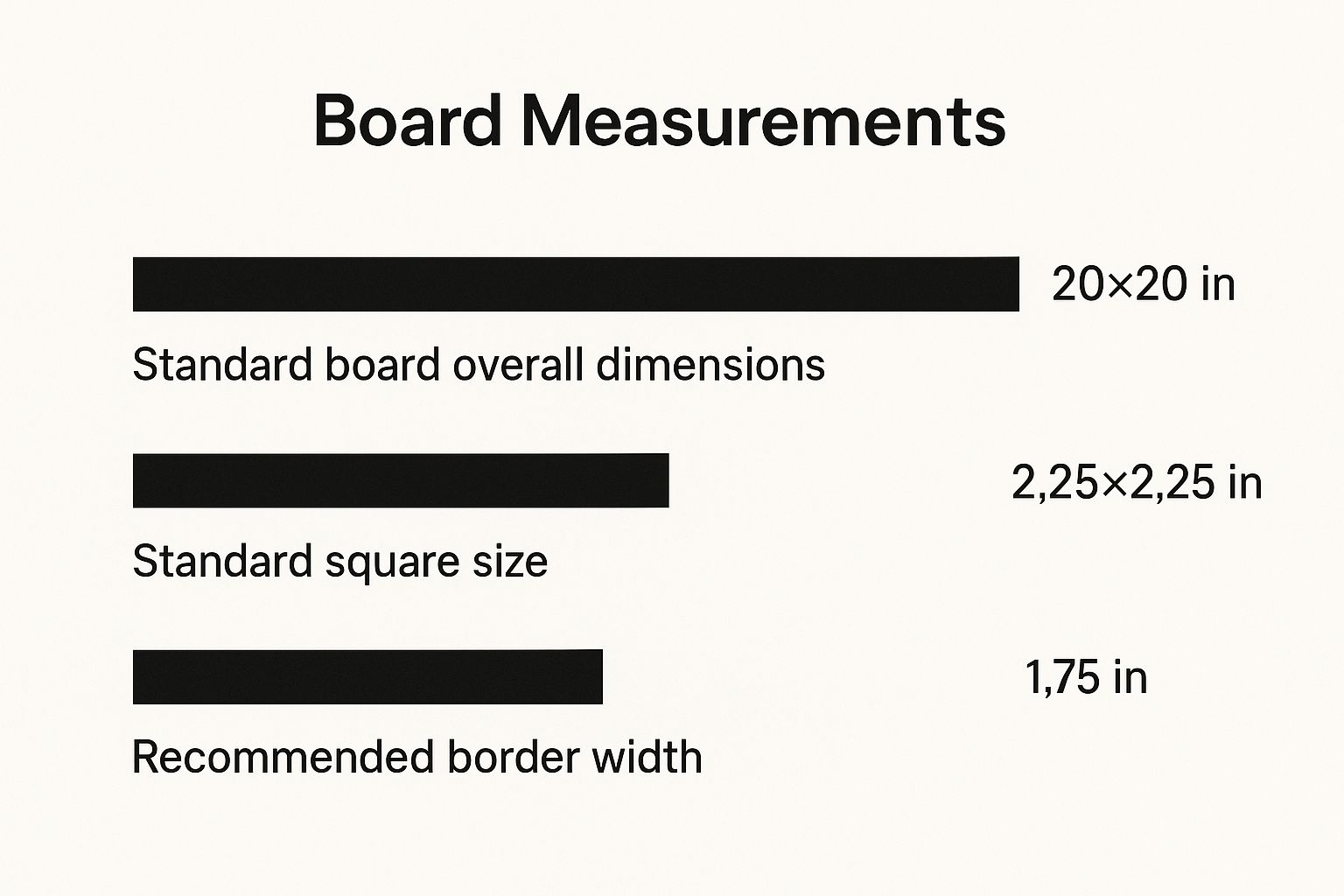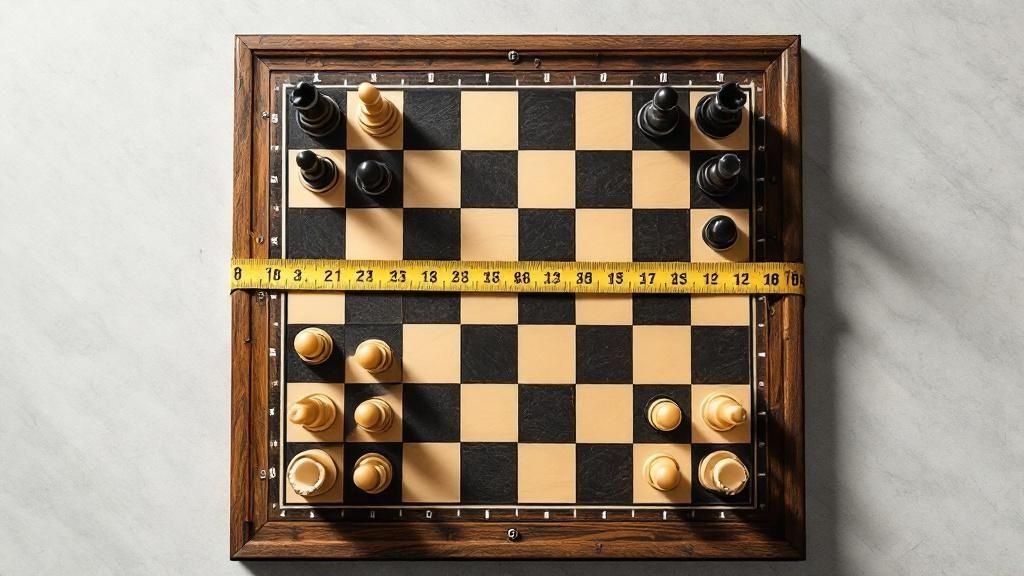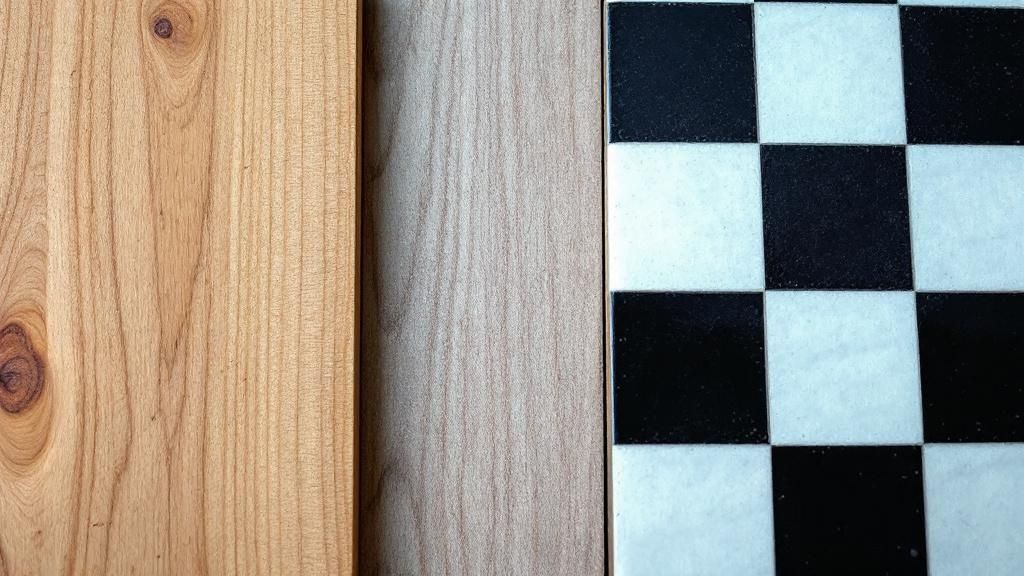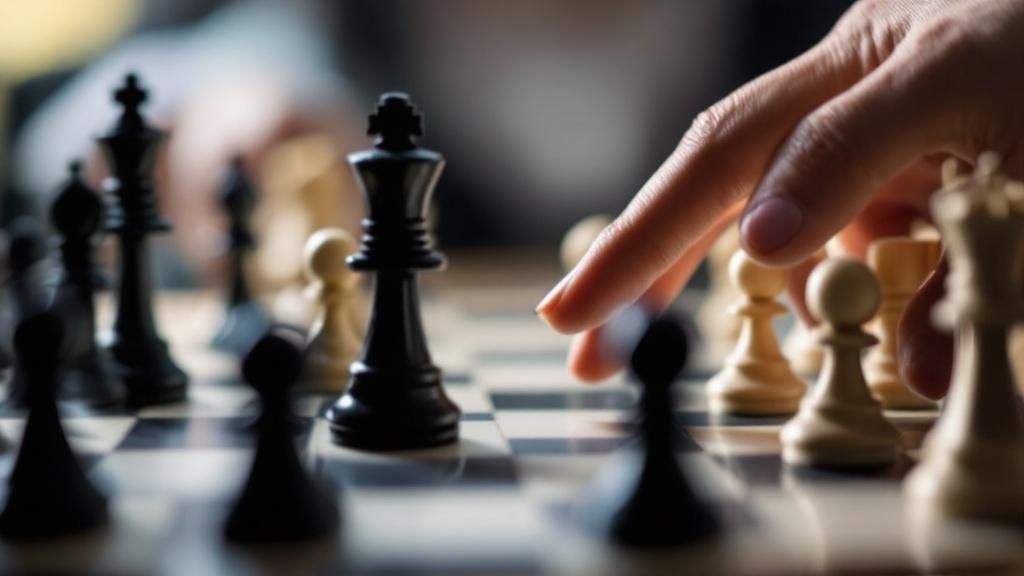When you start looking for a standard chess board size, you’ll quickly discover that the term "standard" is really defined by the rules of official tournaments. The most widely accepted size for a single square is 2.25 inches (5.7 cm). This isn't just a random number; it's a dimension carefully chosen to give players a clear view and comfortable handling of the pieces during intense competitive matches.
Understanding Tournament Chess Board Standards
In a game all about precision and planning, it makes sense that the physical board is governed by strict rules, just like the movement of the pieces. A standard tournament chess board isn't one single size, but rather a narrow range of measurements set by the world's top chess organizations. These guidelines are all about creating a playing field that’s visually clear and ergonomically sound, ensuring the pieces never look crowded or lost on the board.
The two main authorities setting these rules are the World Chess Federation (FIDE) and the United States Chess Federation (USCF). Their handbooks outline the precise dimensions for any board used in a sanctioned competition. This visual breakdown highlights the key measurements you'll see on tournament-grade equipment.

As you can see, that 2.25-inch square really is the foundation of the entire board's design.
FIDE vs. USCF Requirements
While the two federations have very similar guidelines, there are some subtle differences worth noting. Let’s break them down for a direct comparison.
Official Tournament Chess Board Dimensions (FIDE vs USCF)
| Measurement | FIDE Standard | USCF Standard |
|---|---|---|
| Square Size | 5 cm to 6 cm (approx. 2 to 2.4 inches) | 2 inches to 2.5 inches |
| Preferred Size | Not explicitly stated, but trends toward 5.5 cm | 2.25 inches (most common for events) |
| Focus | International and world championship events | National and scholastic events in the US |
Both organizations aim for consistency, but the USCF’s preference for the 2.25-inch square has made it the de facto standard for serious players in the United States. You can discover more about these official chess board regulations and see how they impact everything from piece selection to game analysis.
Ultimately, these standards serve one critical purpose: creating a predictable and fair playing environment. When a player sits down for a tournament game, the board should feel instantly familiar. This allows them to pour all their mental energy into strategy, not waste a single thought on adjusting to unfamiliar proportions.
The Evolution of a Uniform Playing Field

Before the era of standardized rules, the world of competitive chess was a bit like the Wild West. Imagine arriving at a tournament where every board was a different size. One match might be on a sprawling board with miniature pieces, the next on a cramped field where your knight could barely move without toppling a pawn. For centuries, this was the norm.
Chess sets were handcrafted items, reflecting the unique style of their maker or region. The concept of a universal standard chess board size simply didn't exist. This lack of consistency meant the physical board itself could impact the game's outcome just as much as a player's strategic skill. A master accustomed to a spacious playing area might suddenly find their rhythm disrupted by a smaller, cluttered board, adding an unpredictable element to the competition.
The Push for Standardization
The real change began when chess started to get organized. As the game transitioned from a casual hobby to a serious international sport, the need for consistent equipment became glaringly obvious. This movement was spearheaded by the new global organizations created to govern competitive chess.
Historically, the regulation of chessboard size emerged alongside the formal organization of chess tournaments in the 20th century. Before this period, chessboards varied widely. The modern standardization process began as chess became more international and institutionalized. Discover more about how these early chess board dimensions evolved.
The founding of the Fédération Internationale des Échecs (FIDE) in 1924 marked a pivotal moment. FIDE's core mission was to professionalize the game, and a huge part of that was establishing a predictable and fair environment for every player, no matter where in the world a tournament took place.
This wasn't just about administrative rulemaking; it was about elevating the sport. By standardizing the board, the focus shifted entirely to the players' abilities, ensuring that skill alone decided the victor. It also became critical for broadcasting, as the rise of televised matches in the mid-20th century demanded a consistent, easily understood visual for a global audience. This development was essential in shaping chess into the respected competition we know today.
Why Board and Piece Proportions Matter

So, why all the fuss about exact measurements? It turns out that the rules for a standard chess board size aren't just arbitrary numbers plucked from thin air. They represent decades of refinement aimed at creating the best possible environment for play. At the core of this is the careful relationship between the size of the squares and the pieces sitting on them.
Think of it like a theater stage. If the stage is too small, the actors will look crowded and clumsy, making it difficult to follow the action. If it’s too large, they can seem lost and disconnected, robbing the performance of its impact. A chess board operates on the exact same principle.
The Science of Playability
This perfect harmony between the pieces and the board is crucial for both physical handling and mental clarity. It’s a balance achieved through a time-tested guideline known as the King-to-Square Ratio.
This principle is simple: the diameter of the king's base should take up about 75% to 80% of the square's width. This specific ratio delivers several tangible benefits:
- Visual Clarity: It keeps the board from looking cluttered. This allows players to see complex tactical patterns instantly without the pieces blending into a single, confusing mass.
- Comfortable Handling: The pieces are easy to grab and move, even when the clock is ticking. This simple detail reduces the chances of fumbling and knocking over other pieces in a critical moment.
- Balanced Aesthetics: A well-proportioned set just looks right. This harmonious appearance contributes to a more focused and enjoyable playing experience.
When the proportions are off, the game itself can feel wrong. Cramped pieces hide threats and opportunities, while a board that’s too spacious can make the position feel disjointed and hard to read at a glance.
Adhering to these standards has made a real difference in tournament play. The optimal 5-6 cm square size, for instance, perfectly accommodates the average adult hand while enhancing visual perception. Any significant deviation from the king-to-square ratio can be surprisingly disruptive, breaking a player’s concentration and the natural flow of the game. If you're curious, you can learn more about how the evolution of chess sets led to these ergonomic standards.
Ultimately, these carefully considered proportions are what elevate a simple grid of squares into a finely tuned instrument for strategic battle.
How to Choose the Right Chess Board

Knowing the standard chess board size is a great start, but turning that information into the right purchase takes a bit more thought. Finding the perfect board isn't about a single "best" option. It's about matching the board to your life and how you play.
The first question to ask yourself is simple: What is this board for?
Is it for serious tournament practice? Casual games with the family? Or will it be a statement piece for your home? Your answer changes everything. A competitive player needs something entirely different from someone who wants a beautiful set for their study.
Comparing Board Materials
Once you’ve settled on its primary purpose, you can move on to the material. This is a crucial choice, and the three most common options—wood, vinyl, and silicone—each have their own distinct character and purpose.
- Wooden Boards: This is the classic, traditional choice. Nothing beats the aesthetic appeal and satisfying, weighty feel of a quality wooden board. They are perfect for a permanent setup at home but aren't built for the road; they're heavy, rigid, and don't appreciate being knocked around.
- Vinyl Boards: The true workhorse of the chess community. These boards are affordable, tough, and roll up easily for travel to a tournament or your local club. Their main drawback is a tendency to hold creases if they're stored rolled up for too long.
- Silicone Boards: A modern improvement on vinyl, silicone boards are incredibly flexible. You can fold, roll, or even crumple them, and they'll lay perfectly flat every time. They're also waterproof and have a grippy surface, making them a fantastic choice for kids or outdoor games.
Ultimately, the decision often boils down to portability versus permanence. If you need a set that can travel, silicone is tough to beat. For a board that stays put and makes an impression, the timeless elegance of wood is unmatched.
Matching Pieces to Your Board
The final, critical step is making sure your pieces and board are properly scaled to one another. This is where the standard chess board size rules become truly practical. For a setup that looks right and plays well, you’ll want the base of your king to take up about 75% of a single square's width.
For example, a standard tournament-style king often has a 1.75-inch base. That king feels right at home on a board with the popular 2.25-inch squares, achieving that ideal visual balance. Getting this ratio correct is a small detail that makes a world of difference, separating a professional-feeling set from one that just looks mismatched.
Once you have your perfectly matched board and pieces, you'll want to check out our expert guide on how to set up a chess board correctly.
Common Myths About Chess Board Sizes
https://www.youtube.com/embed/KgRfs2M6sXQ
When you first start looking for chess equipment, it’s easy to get lost in a sea of conflicting information. There are quite a few persistent myths floating around, especially when it comes to finding a standard chess board size. Let's clear the air and debunk some of the most common misconceptions you'll encounter.
One of the biggest myths is that a board’s material is what makes it official. It's a common assumption: a heavy, ornate wooden board must be "tournament-ready," while a simple, roll-up vinyl board is only for casual games at the park. That couldn't be further from the truth.
The core lesson is this: an expensive, beautifully crafted wooden board can easily be non-regulation if its squares are the wrong size. Conversely, a basic, inexpensive vinyl or silicone board can be perfectly compliant for tournament use if it meets FIDE or USCF dimension standards.
The rulebooks for competitive chess care about one thing above all else: geometry. It all comes down to the precise measurement of the squares—which should be between 2 and 2.5 inches—and how the pieces fit proportionally within them.
Size vs. Quality
Another widespread fallacy is the idea that "bigger is always better." It’s tempting to imagine that a massive board creates a more epic battlefield, but this often just makes for a clunky, awkward game. If the board is too large for the pieces, the entire position can feel disconnected and visually jarring.
What truly matters for playability is the relationship between the king's base diameter and the square size. A standard tournament king looks and feels lost on an oversized square, which can surprisingly make it harder to spot tactical patterns at a glance.
Finally, some players are led to believe that only officially branded or certified boards are acceptable for serious play. While a certified board is a surefire way to know you're compliant, any board that meets the dimensional criteria is perfectly fine for practice and most competitions.
-
Myth: An expensive board is a better board for serious play.
-
Fact: Price and material don't matter for official standards; only the dimensions count.
-
Myth: Any large board is good for a tournament.
-
Fact: Proportions are key. The squares must be the right size for the pieces.
Keeping these facts in mind will help you make a much smarter purchase. If you're just starting your journey, focusing on a regulation-sized board is far more important than the material it's made from. You can explore some of the best chess sets for beginners that rightly prioritize proper dimensions over unnecessary, and often expensive, frills.
Answering Your Questions About Chess Board Sizes
Even after digging into the official rules, a few practical questions always pop up when you're ready to choose a board. Let's tackle some of the most common ones so you can feel completely confident in your decision.
Think of this as a final run-through, clarifying those last few details before you pick the perfect board for your needs.
What Is the Most Common Tournament Chess Board Size?
If you walk into almost any major tournament, especially in the U.S., you'll find one size dominates all others: a board with 2.25-inch squares. That's about 5.7 cm.
This size hits the sweet spot. It sits comfortably within FIDE’s official range (2 to 2.4 inches) and provides the perfect playing field for standard 3.75-inch tournament pieces. It gives players enough room to see complex positions clearly and maneuver pieces without feeling cramped, which is crucial when the clock is ticking. It has truly become the unofficial standard for serious clubs and competitive players.
Do I Need a FIDE-Approved Board for Home Play?
Absolutely not. The official "FIDE-approved" stamp is really only necessary for the highest echelons of international tournament play, where perfect uniformity is required.
However, if you or someone in your family is serious about competing, practicing on a regulation-sized board is a huge advantage. Using a board with squares between 2 and 2.5 inches helps build the spatial awareness and muscle memory that makes a real difference in a tournament setting. Once you have your set, taking good care of it is just as important; you can find great tips on choosing the right chess set storage to keep it in top shape.
How Do I Match My Chess Pieces to a Board?
The secret to a visually balanced and playable set lies in a simple ratio: the king's base diameter versus the square size. A good rule of thumb is that the square should be about 1.25 to 1.3 times wider than the base of your king.
For example, a standard tournament king often has a base of 1.75 inches. Multiply that by 1.28, and you get about 2.25 inches—the perfect square size. This formula ensures your pieces have enough elbow room without looking small or isolated on the board.
Are DGT Electronic Boards Regulation Size?
Yes, they are. The electronic boards you see in major broadcasted tournaments, particularly from the leading brand DGT (Digital Game Technology), are built to meet strict FIDE and USCF standards.
Their flagship boards usually have 5.5 cm squares (roughly 2.17 inches), which falls squarely within the regulation size. This ensures that professionals playing on them have the same experience as anyone using a standard tournament set at home.
At MarbleCultures, we believe a game set should be both a source of joy and a work of art. Explore our curated collection of high-quality, artisanal chess sets that honor the classic game with timeless style. Find your perfect heirloom set at MarbleCultures today.

